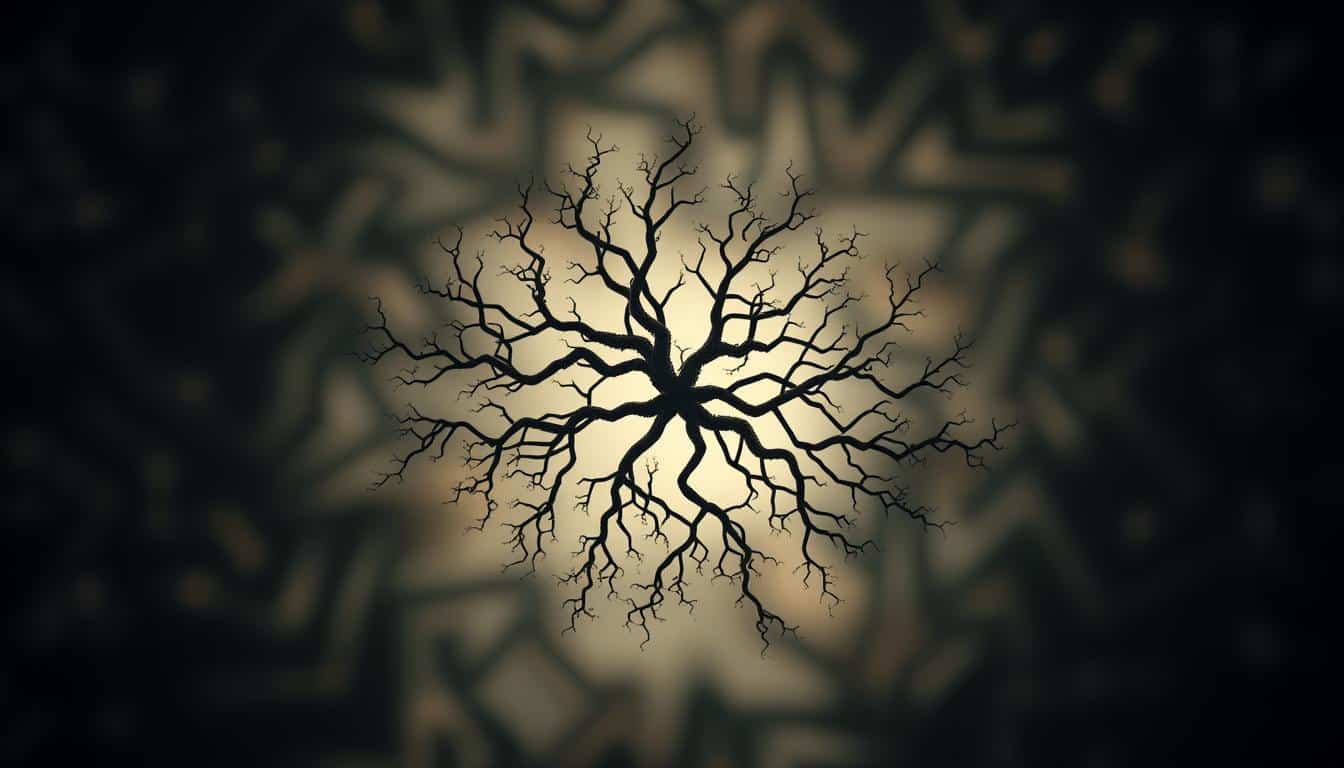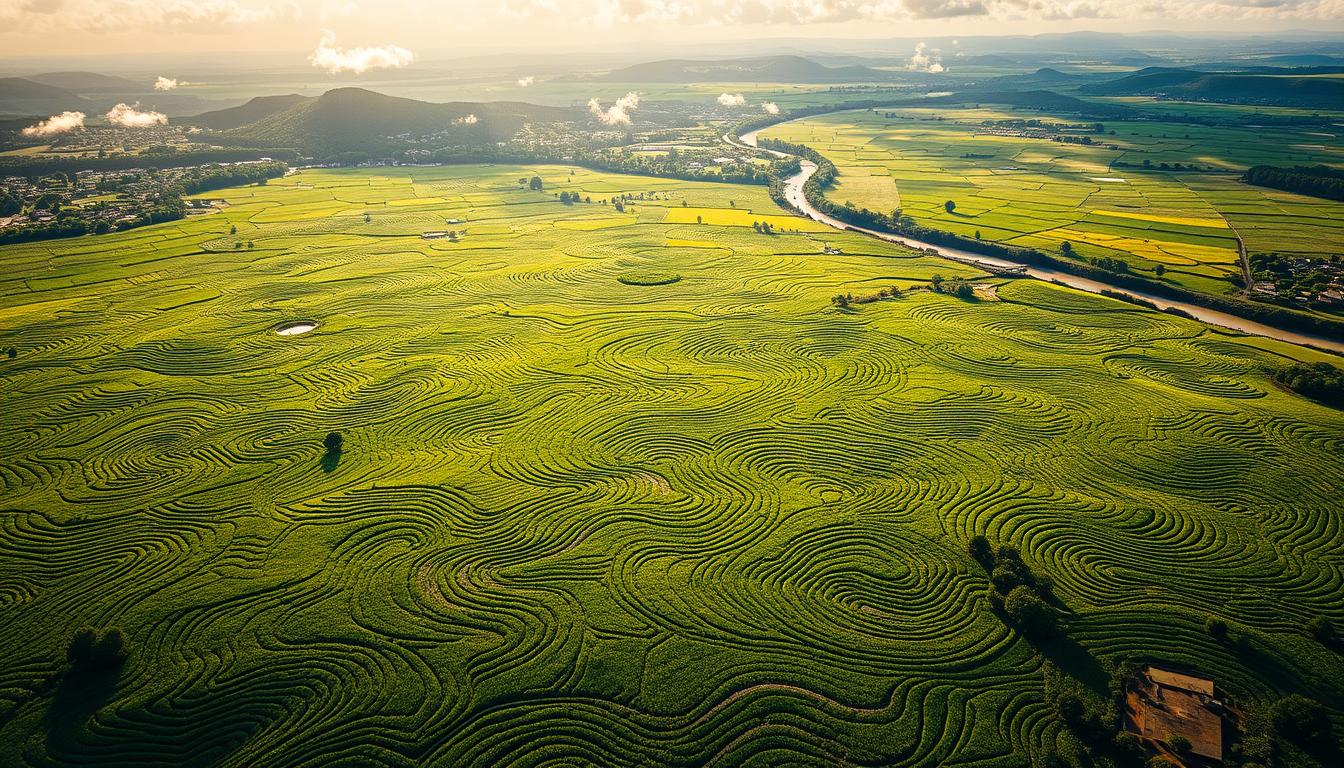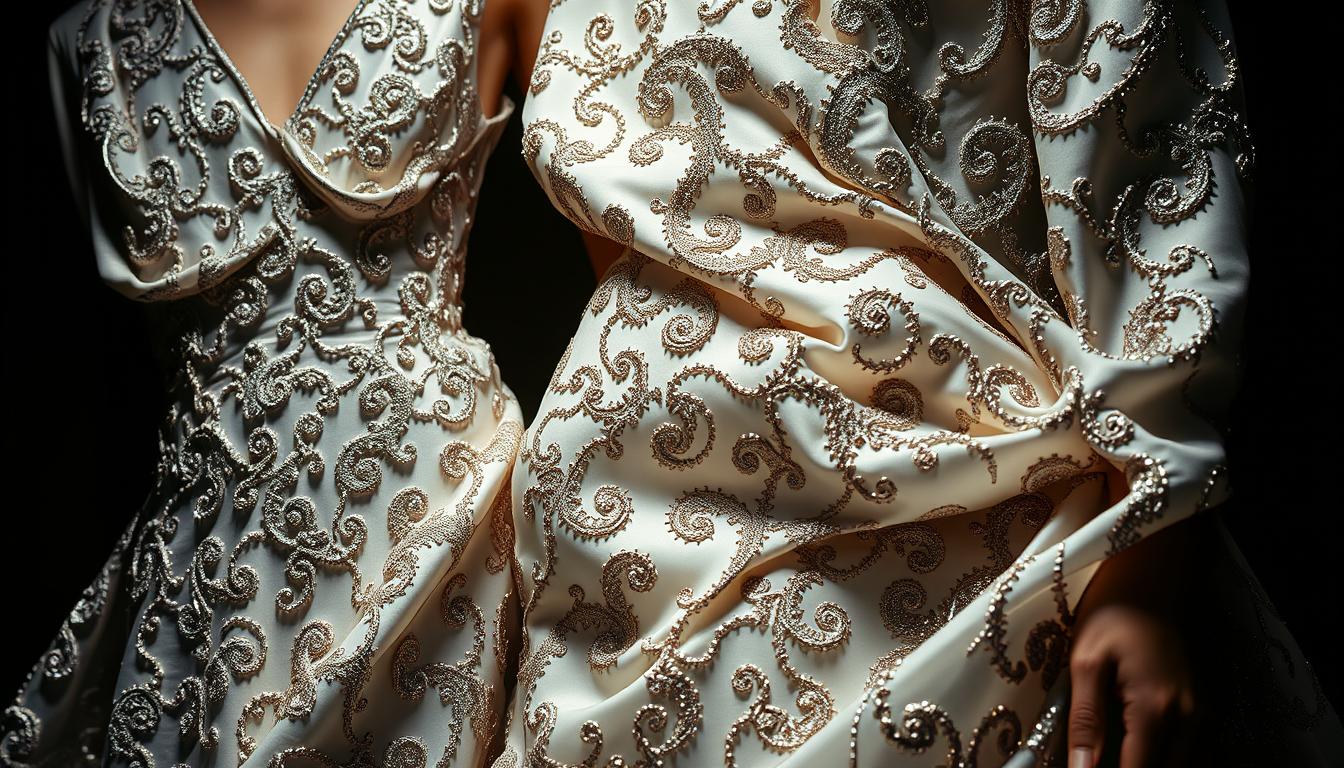Fractals are intriguing structures made by repeating simple steps, which lead to complicated patterns. These patterns are seen in nature and technology. Fractals help make data visualization better and computer graphics more realistic.
Their use in technology spans many areas, including telecommunications and medicine. We’ll see how fractal algorithms address complex challenges. This journey will show us the important role of fractals in nature and how they push technology forward.
The Origins of Fractals
The story of fractals starts with many mathematicians, but Benoît Mandelbrot shines the brightest. In the 1970s, Mandelbrot made fractals a big topic in math and showed us how they fit into different fields. The word “fractal” comes from the Latin “fractus,” which means broken or uneven, perfectly describing their detailed patterns.
Fractals show us how to see the complexity in nature. Normal shapes can’t catch the wild patterns we see outdoors. Fractals let us explore the shapes of trees, the layout of leaves, and the lines of coastlines. This story tells us how fractals give us new ways to understand math and the world around us.

Understanding Fractals and Self-Similarity
Fractals are an interesting part of math, known for their special feature called self-similarity. This means when you zoom into a fractal, the complex patterns still look like the bigger picture, no matter how close you get. There are three types of self-similarity: self-similar, self-affine, and invariant. Each type shows different ways fractals can behave and pattern themselves.
Fractal geometry uses something called fractal dimensions. This isn’t like normal dimensions that measure length, area, and volume. Fractal dimensions measure how complex a fractal is. For example, a fractal can have a dimension that’s higher than its regular dimension. This shows it has a level of detail traditional measurements can’t see. Fractals can mimic many natural things, making them very useful in science.
The use of fractal geometry is widespread, from computer graphics to data visualization. By understanding self-similarity and fractal dimensions, we can better use fractals to simulate real-life situations. This improves not only how things look but also their functionality.
Fractals in Technology: Applications in Data Visualization and Computer Graphics
Fractals are changing how we see data and graphics. They help create detailed patterns and true-to-life scenes. Such tools are key for making computer landscapes and textures that draw people in. They’re used in video games and movies to enhance the realism.
The Role of Fractals in Computer Graphics
In computer graphics, fractals are essential for adding texture and making environments. They let creators form real-looking places without detailing every part by hand. With fractal noise, like Perlin noise, artists make everything from rolling hills to clouds. Movies like Avatar use these methods to make vast, believable worlds.
Terrain Generation with Fractals
Fractal algorithms play a big part in making varied terrains. This technique lets creators make changing landscapes while saving on computing power. It makes games and stories more exciting and good-looking. Fractals and special effects together create unforgettable scenes that deeply impress viewers.
Fractals in Animation: Creating Realism
Fractals are key to making animations look real. They have patterns that repeat and look like things in nature, helping create lifelike images in movies and games. In visual and special effects, fractal animation helps show things like smoke and fire very realistically.
Visual Effects and Special Effects in Media
Using fractal patterns makes visual effects better. Animators create complex scenes that look natural thanks to these patterns. This is true for movies and video games. Scenes built with fractal animation draw in the audience. Plus, fractals make it possible to add lots of detail without using too much computer power. This makes them super useful in today’s animation work.
Fractals in Signal Compression and Image Processing
Fractals are key in making signal compression better, especially with images. They use patterns that repeat to make encoding data better. By spotting these patterns in images and videos, fractal compression cuts down file sizes. It does this without losing quality. This is great for areas that need to move a lot of data fast.
Efficient Data Encoding Techniques
Fractal compression methods boost data encoding in a big way. They find repeating structures in data, which helps store and send it better. Fractal signal compression has some main advantages:
- Reduction of file sizes while preserving image fidelity.
- Minimized bandwidth usage during data transfer.
- Facilitating quicker access and retrieval of large datasets.
Applications in Medical Imaging and Satellite Imagery
In medical imaging and satellite photos, fractal compression works wonders. It keeps important details in MRI and CT scans while making files smaller. For satellite photos, which need to be very clear, it also lowers file sizes. This makes storing and sharing them more efficient. Fractals are proving to be a big help in medical tests and watching the Earth.
Fractal Antennas in Telecommunications
Fractal antennas are a big step forward in telecommunications. They mix new design with usefulness. These antennas have self-similar patterns. This lets them work well across many frequency bands. The fact that they can fit into small devices like smartphones and IoT gadgets is vital. This is because we all want smooth wireless communication to keep getting better.
Compact and Multi-Band Designs for Modern Devices
Today’s quick tech world benefits from the small size of fractal antennas. Older antenna types need a lot of space, making them a poor fit for sleek, carry-around gadgets. Fractal antennas use their shape to offer:
- Reduced size without sacrificing performance
- Improved reception and transmission capabilities
- Adaptability to various telecommunications standards
Multi-band antennas are super important for handling the many frequencies in wireless communication. Thanks to fractal geometry, these antennas stay effective and useful across different bands. This makes them perfect for tech that needs to be flexible. As our telecom tech grows, fractal antennas will likely lead to even more improvements in wireless communication.
Fractal Analysis in Medicine
Fractal analysis is changing how we see medicine. It helps us understand complex body structures better. Structures like the human vascular network, lungs, and brain follow patterns seen in fractals. This analysis helps spot diseases early by finding these patterns.
Understanding Biological Structures through Fractals
Looking at biological structures with fractals shows us details we might miss otherwise. By using fractal analysis, experts can spot important features in:
- Vascular systems, helping to assess blood flow and detect irregularities.
- Lung structures, aiding in the evaluation of respiratory diseases.
- Brain patterns, contributing to the understanding of neurological conditions.
Applications in Medical Imaging
Fractal analysis is becoming key in improving medical imaging. It makes scans like MRI or CT more useful. This is because it helps doctors see patient health in new ways. Important uses include:
- Improving the accuracy of tumor detection in imaging scans.
- Enhancing the clarity of images, revealing microstructures not visible through conventional imaging.
- Enabling the analysis of growth patterns over time, particularly in chronic diseases.
Fractals in Data Networks and the Internet
Fractals are changing the way we handle data networks. They help make the Internet faster and store data more efficiently. Their patterns are similar to structures in nature. This makes them great for moving data smoothly.
The need for quick data processing is skyrocketing. That’s why these math ideas are key for today’s networks.
Optimizing Data Routing with Fractal Algorithms
Fractal algorithms make data flow better through networks. They use patterns that connect bits of data more efficiently. This is like how branches spread out from a tree.
This is super important for things like cloud computing. There, every second counts for speed and getting things right.
Improving Data Storage Efficiency
Fractals also make storing data better. They arrange huge amounts of data. This way, it’s easy to keep and find info when needed.
This is crucial as we create and store more data in areas like business and science. Using fractals helps keep all that information organized and easy to access.
Fractals in Art and Design
Fractals are a major source of inspiration in art and design fields. Their complex patterns mirror natural beauty closely. Artists use these fractal patterns to create captivating digital works. This challenges old ways and grabs audience attention.
Exploring Fractal Art and Digital Creativity
Fractal art combines math with artistic vision, letting artists create stunning visuals. By using special software, they make shapes and colors that look like nature. This style shows off both their creative and math skills. It’s now key in digital art.
Architectural and Product Design Inspired by Fractals
Fractals aren’t just for visual arts—they also inspire buildings and products. Architects use fractal ideas to make buildings that are both good-looking and functional. This approach uses patterns from nature, making designs sustainable and efficient.
Product designers also use fractals to make appealing and innovative items. Adding fractal designs improves the look and function of products. This makes for a better experience for users, with items that are eye-catching and useful.
Conclusion
Fractals play a big role in technology, touching fields like computer graphics and medicine. They make complicated things simpler, boosting efficiency. This is because they mirror nature’s own designs, inspiring new tech breakthroughs.
Looking ahead, fractals will keep being important. They’ll help make computer simulations more lifelike and improve communication systems. The mix of science and creativity in fractals will lead to big changes in many areas.
Fractals bridge nature and tech in special ways. They help us improve how we use technology today and inspire new ideas for the future. This shows fractals will always be relevant in shaping technology and our world.



